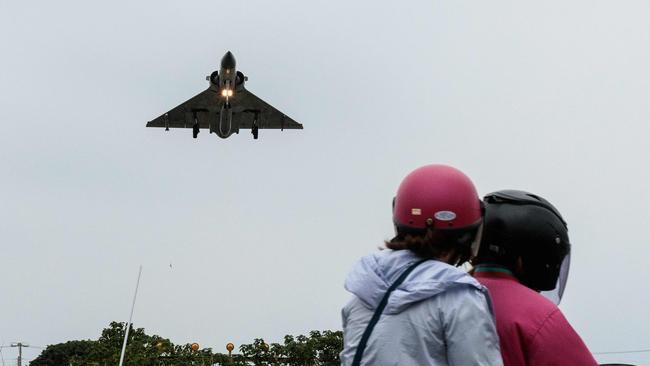Deadly new Chinese missile could ‘destroy entire US fleet’ in 20 minutes
Experts have warned that a Chinese bomber carrying a new hypersonic missile could “destroy everything” in just 20 minutes.
The sight of a Chinese bomber carrying a heavy new type of hypersonic missile has heightened fears that it has found a way to counter America’s most potent weapon – its 80,000-tonne nuclear-powered aircraft carriers.
The Trump administration’s controversial Secretary of Defence Peter Hegseth has told US media that the United States Navy and Marine Corps “loses to China in every war game”.
In particular, the Pentagon Chief says China’s new arsenal of guided hypersonic missiles “can take out 10 aircraft carriers in the first 20 minutes of the conflict”.
“So far, our whole power projection platform is the aircraft carrier and the ability to project power that way strategically around the globe,” he added.
It’s just the latest high-level expression of fear since China unveiled its intentions to build a vast array of relatively cheap, ultra-long-range, ultra-fast missiles capable of bypassing all known defences in the early 2000s.
According to the US Defence Department’s most recent report on Chinese military power, Beijing has “dramatically advanced its development of conventional and nuclear-armed hypersonic missile technologies” over the past 20 years.
Among them is the YJ-21 hypersonic missile specifically designed to target aircraft carriers.
But the missiles have implications reaching far beyond the pride of the US Navy. Australia’s own warships, especially helicopter-carrying troopships, are far more vulnerable. And most of the northern bases housing Australia’s small fleet of expensive, not-yet fully operational F-35 Stealth Fighters can be hit with little more than a minute’s notice.
The Pentagon admits it does not know how many such weapons the Chinese have.
But Hegseth’s dire prediction reveals a deep-set concern that they can defeat the existing interceptor missiles, guns and decoys intended to defend surface ships from attack.
US aircraft carriers are massive ships.
The USS Gerald R. Ford is 337m long and 77m wide. It weighs about 100,000 tonnes and carries about 75 combat aircraft.
The $A20 billion ship carries a crew of some 4500.
And it’s the most modern of the US fleet of 11 similar nuclear-powered aircraft carriers.
“If we get into a war with China, we should expect to lose some carriers,” says Center for a New American Security think-tank analyst and former US Navy Captain Thomas Shugart.
“The question is: Are the objectives we’re trying to fulfil going to be worth it in the view of the American public and its political leadership.”
Price of war
Modern aircraft carriers are built to be hard targets.
On one level, they’re simply huge. But the harsh lessons of World War II have taught the world’s navies just how vulnerable these ships can be.
“The Navy has put great effort into carrier survivability with extensive compartmentalization, systems duplication, and damage control,” says Center for Strategic and International Studies.
“Armoring, voids, watertight fittings, fixed damage control systems, [and] damage control training all add to the survivability of carriers, as does significant redundancy in propulsion and power generation.”
However, Japanese kamikaze attacks in the dying days of World War II showed that sinking such ships wasn’t necessary. Wrecking their flight decks was sufficient for a “mission kill” – making the ships useless.
“China has a deep magazine of long-range weapons and a located carrier would be very difficult to defend and keep operating,” Cancian told Popular Mechanics.
If just one carrier was sunk, the loss of its 5500 sailors would exceed US losses in the Afghanistan and Iraq wars. And a 2023 CSIS war game predicted defending Taiwan from China’s Chairman Xi Jinping would likely involve losing two carriers.
Communist Beijing has openly stated it intends to seize control of Taiwan, by force if necessary.

It has hinted it plans to have its military ready to achieve the task by 2027.
“If the US decides it cannot risk its carriers in areas these weapons can reach, it’s effectively denied the ability to enter into or operate there, a strategy known as “Anti-Access/Area Denial,” Cancian explains.
That risk extends to bases these weapons can reach.
And that includes the US Marine presence in Darwin.
“Integrated air and missile defence (IAMD), without which our northern bases are exposed to attack, should be made a top priority,” Australian Strategic Policy Institute (ASPI) analyst Dr Malcolm Davis argues in a new assessment of national defences ahead of the federal election.
“This area has been underinvested in by the current government despite advice in the 2023 DSR urging the government to fast-track the acquisition of effective IAMD capability. The 2024 NDS and IIP did announce significantly increased investment into the ADF’s northern base infrastructure to prepare it to support high-intensity military operations, which is important but less effective if the bases can’t be defended.”

Secret weapons
Chinese state-controlled media has this month released footage of one of its H-6K bombers carrying what appears to be an operational version of a new ballistic missile.
The KD-21 ALBM (air-launched ballistic missile) was first spotted at an airshow in 2022. But this is the first time it has been seen attached to a frontline squadron aircraft.
The footage shows a bomber carrying a pair of the “carrier-killer” weapons during a recent military exercise.
Its exact characteristics and purpose are unknown.
But analysts point to similarities with Russia’s Kinzhal AS-24 weapon that has been deployed against Ukraine.
The Kinzhal appears to be a relatively simple ballistic missile that soars high above the atmosphere before plunging on its target at hypersonic speeds. But the predictability of its flight path makes it possible to intercept with modern defences.
What concerns US analysts about the new Chinese weapon is its believed ability to “skip” along the Earth’s atmosphere-space boundary, making it much harder to see and track.
Whatever the case, the new weapon significantly improves the reach of China’s bomber force. It can fly at speeds greater than five times the speed of sound (6174km/h) to reach targets up to 1000km distant. And the H-6K bomber can carry it up to 6000km before launching it – even without in-flight refuelling.
But the KD-21 is just one of several missiles being deployed by Chinese bombers. Another, the KF-21, is much larger and is believed to carry a hypersonic glide vehicle. These are designed to reach immense speeds before dipping below the horizon and weaving through the sky, making its final approach much more difficult to intercept.
Similar, but bigger, missiles are being built for China’s land-based missile force.
Combined, these weapons put every major US military facility, from Alaska to Guam and Darwin, well within Chinese first-strike range. And nuclear-powered aircraft carriers – while capable of moving significant distances at high speeds – can now be readily tracked by swarms of small spy satellites.
“Quite frankly, the carrier has been under threat from one weapons system or another for generations,” Shugart concludes. “The difference, I think, is that the level of risk has certainly gone up.”
Jamie Seidel is a freelance writer | @jamieseidel.bsky.social
Originally published as Deadly new Chinese missile could ‘destroy entire US fleet’ in 20 minutes





